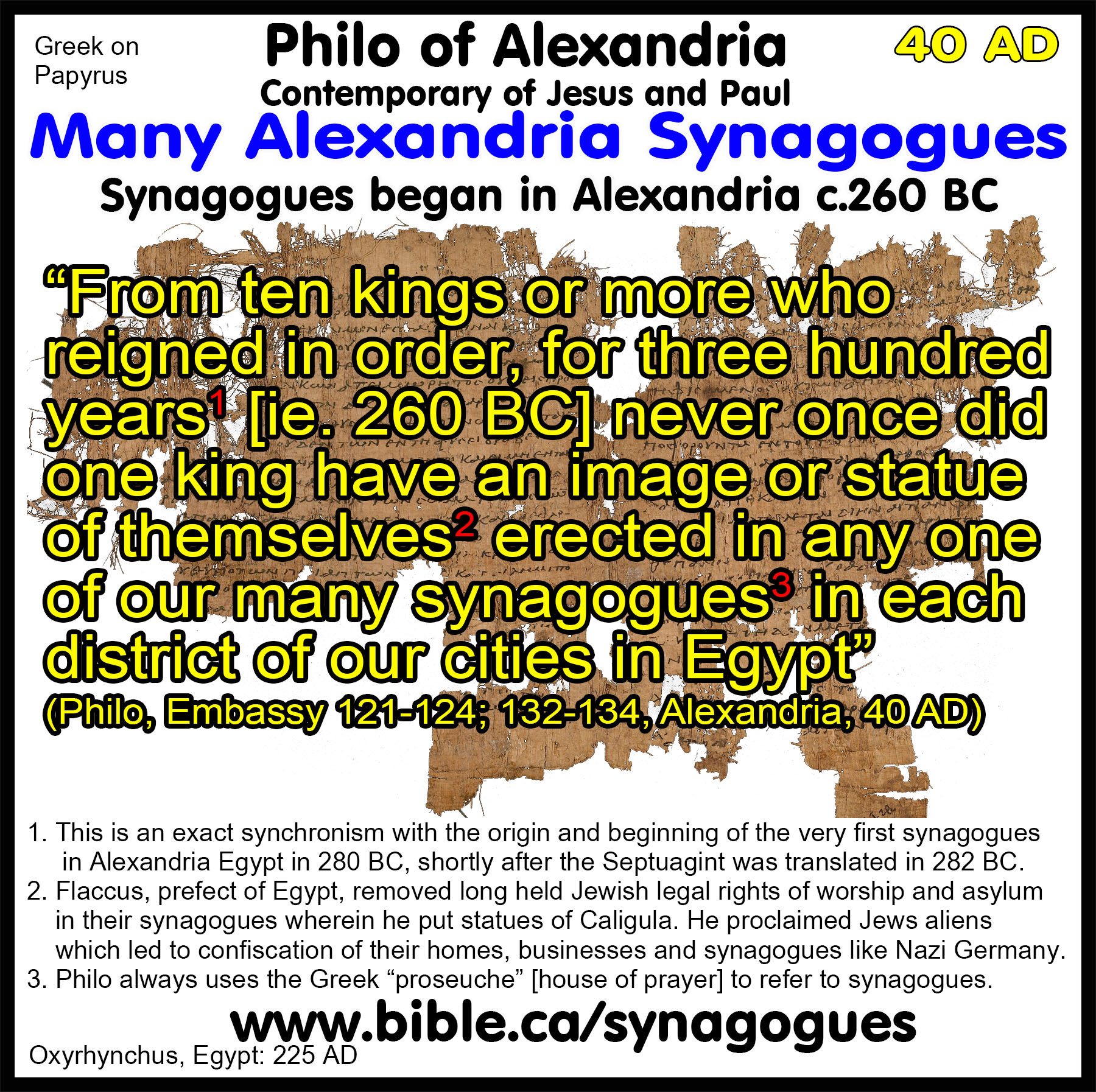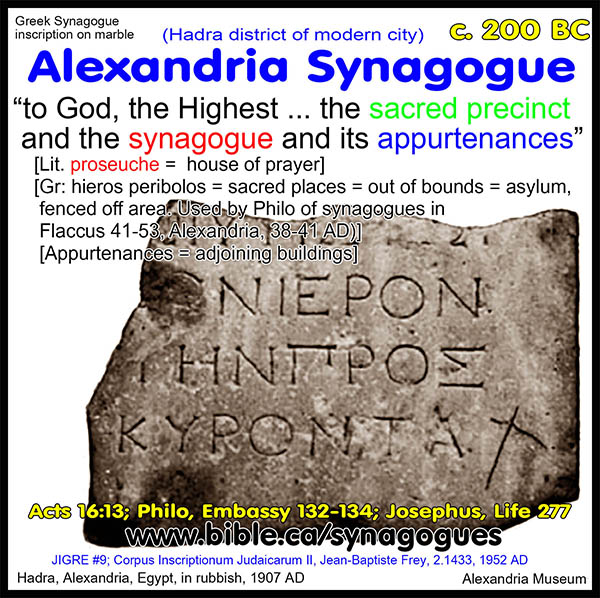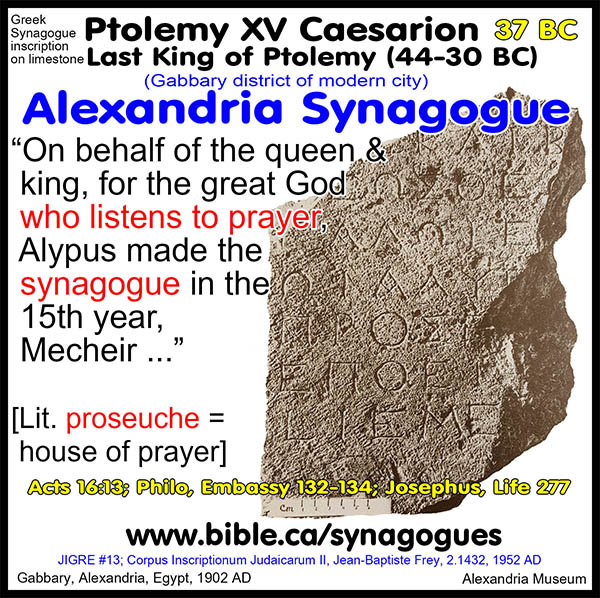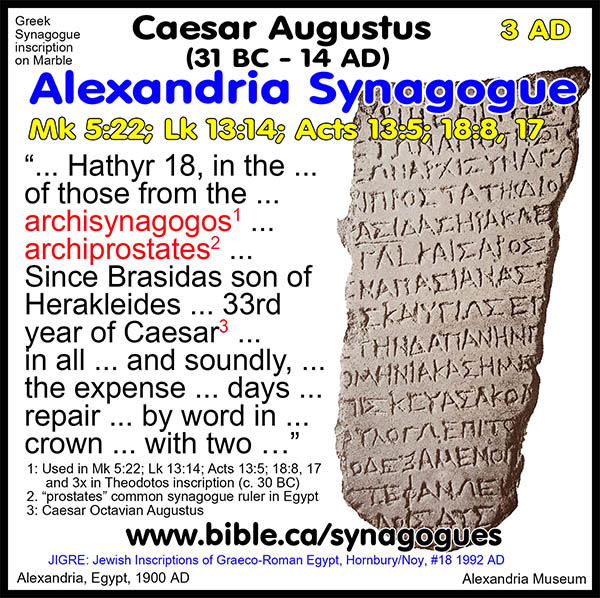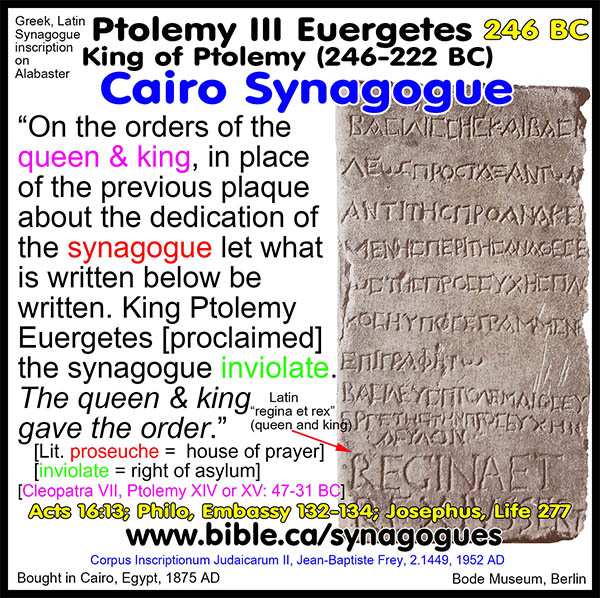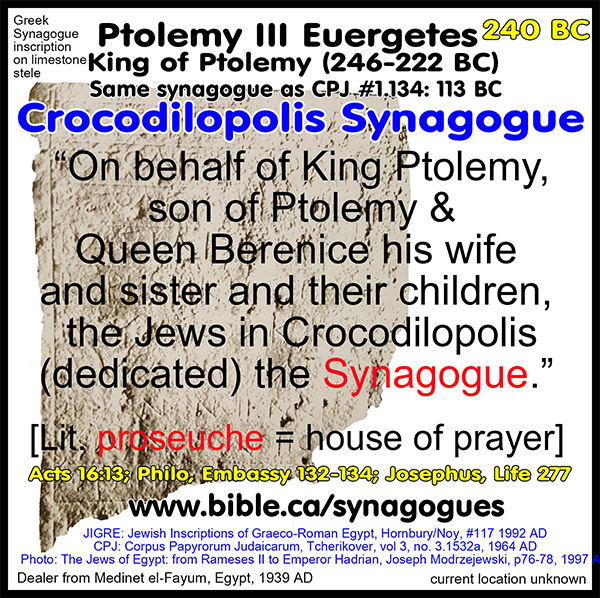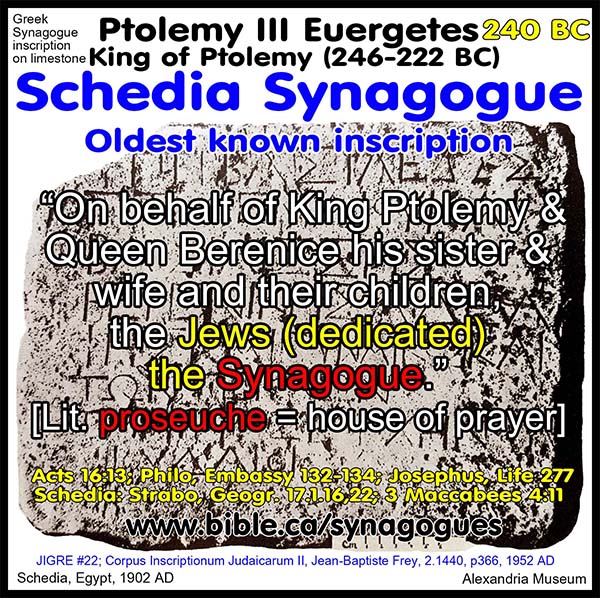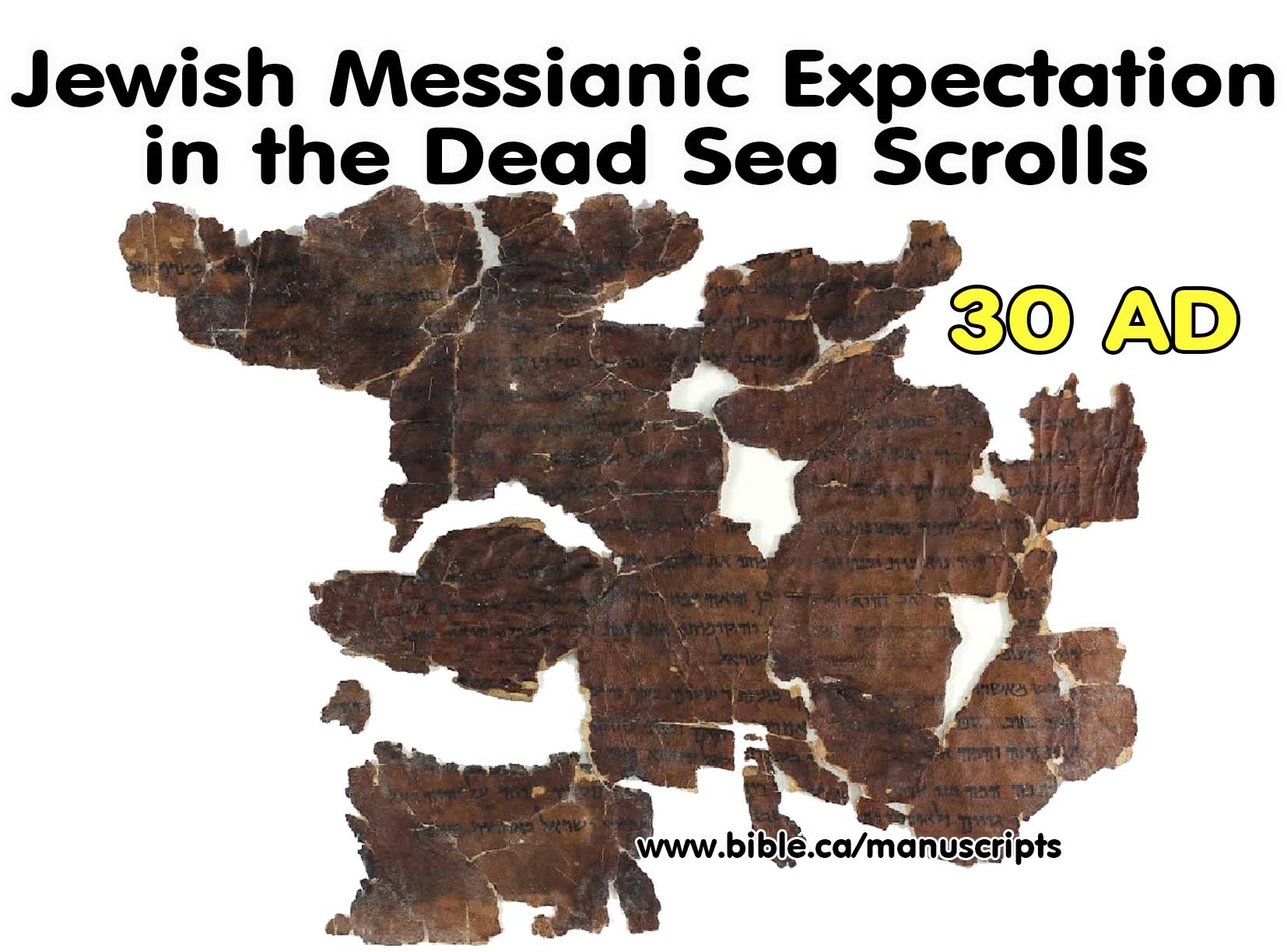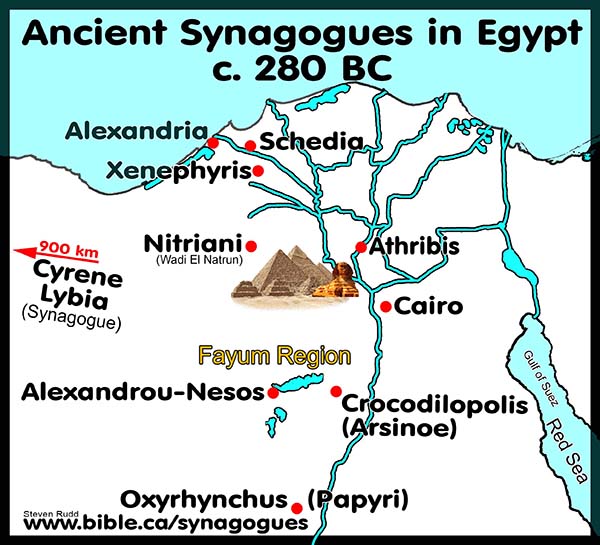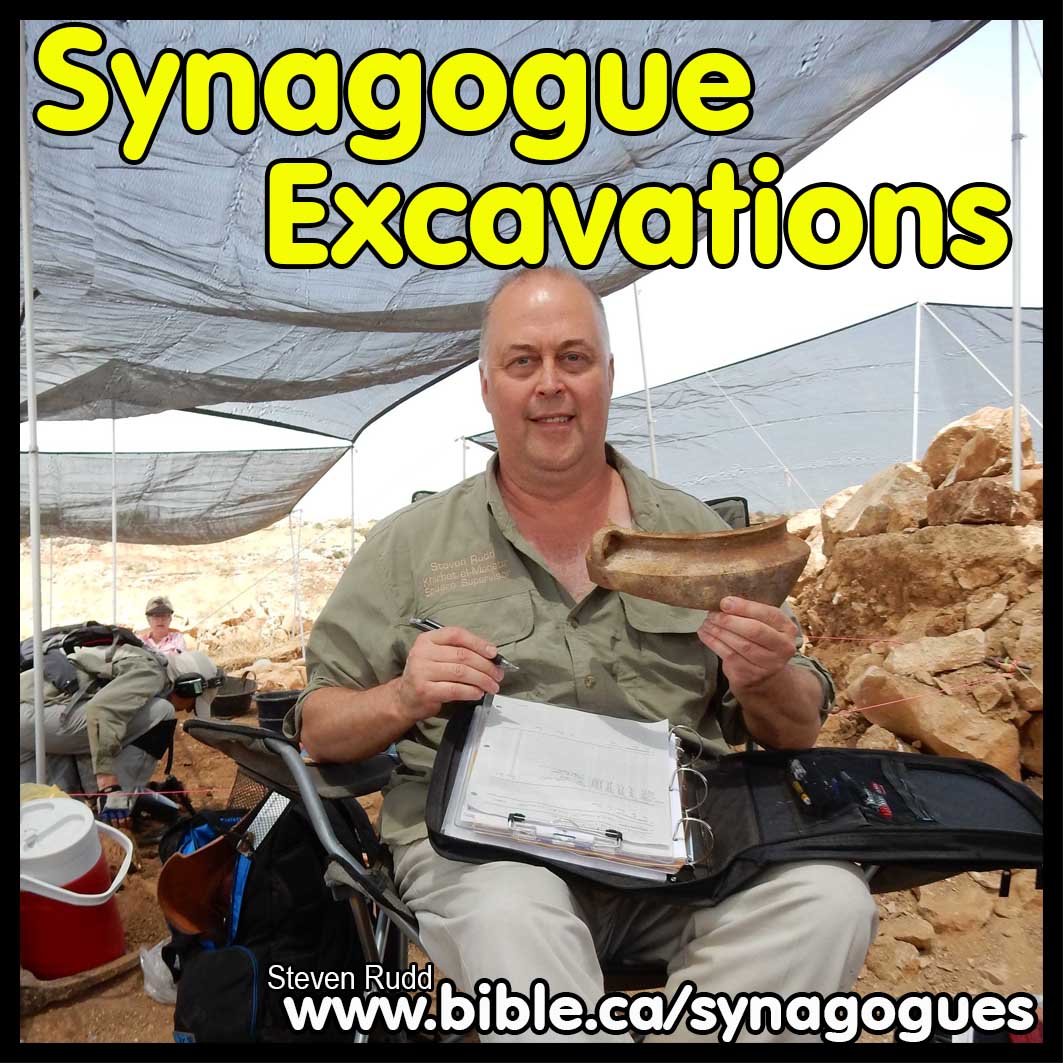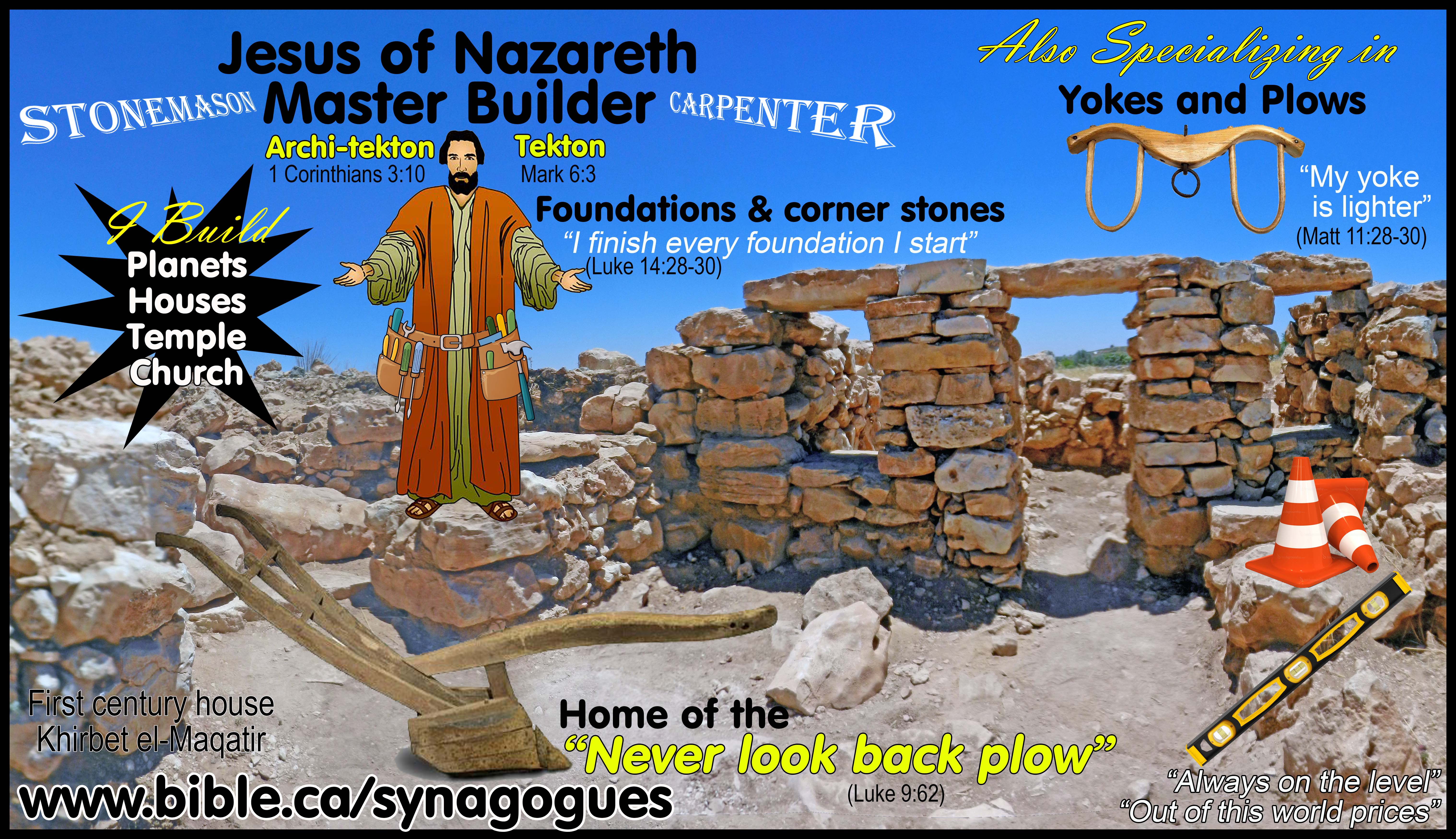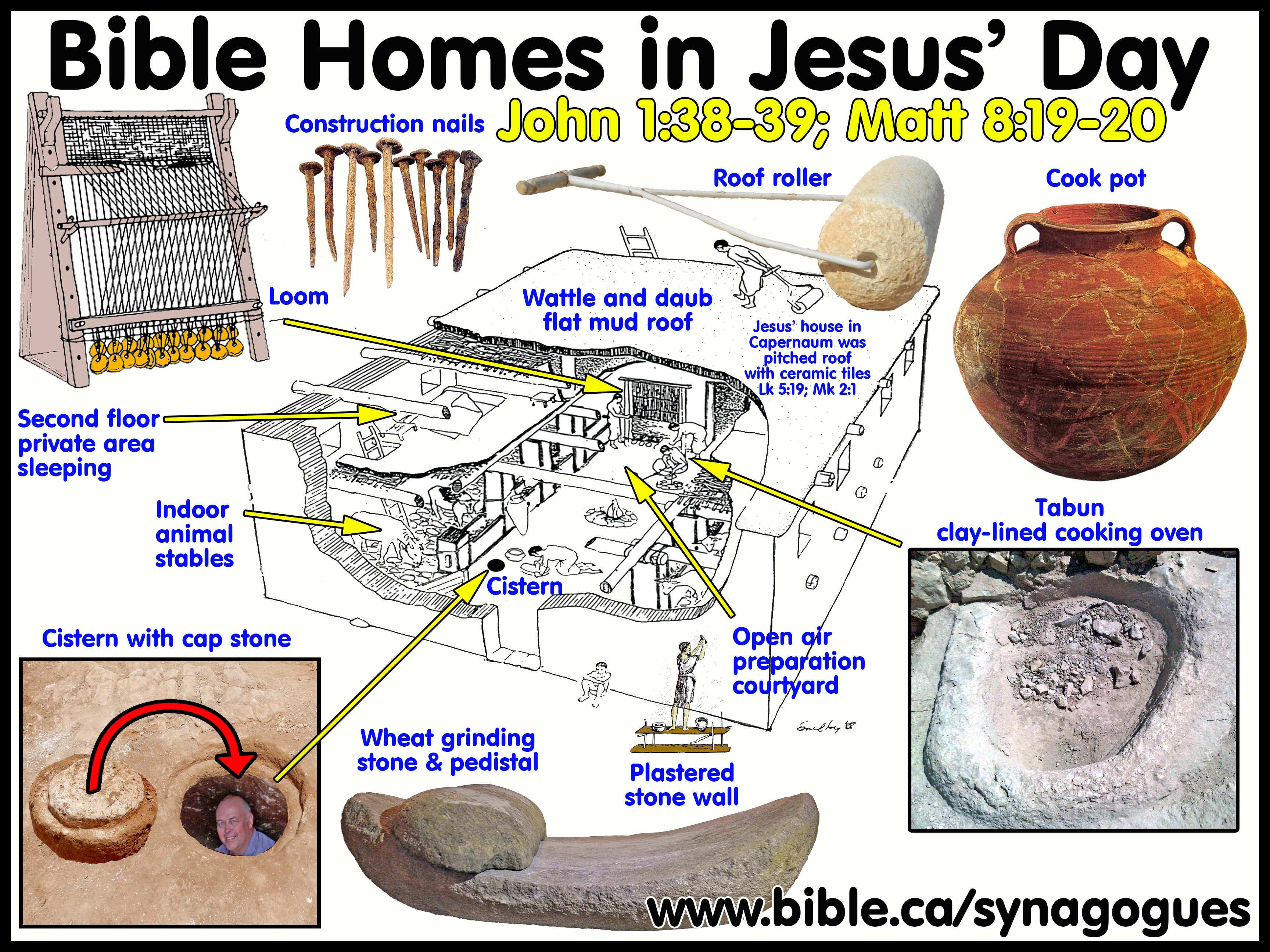Philo of Alexandria
Contemporary of Jesus and Paul
Uses the Genesis chronology numbers of the Septuagint
Ancient Synagogue Literary Sources
25 BC – 50 AD
(Philo Judaeus)
Philo tells us that Synagogues began around 262 BC in Alexandria Egypt
(Philo, Embassy/Legat. 121-124; 132-134, Alexandria, 38 AD)
Philo tells us that Synagogues began around 262 BC in Alexandria Egypt:
“From ten kings or more who reigned in order, for three hundred years [ie. 260 BC] never once did one king have an image or statue of themselves erected in any one of our many synagogues in each district of our cities in Egypt” (Philo, Embassy/Legat. 121-124; 132-134, Alexandria, 41-45 AD)
The Second Temple basilica-synagogue of Alexandria: 380 BC- 117 AD (destroyed by Trajan)
“But as the governor of the country [Flaccus], who by himself could, if he had chosen to do so, have put down the violence of the multitude in a single hour, pretended not to see what he did see, and not to hear what he did hear, but allowed the mob to carry on the war against our people without any restraint, and threw our former state of tranquillity into confusion, the populace being excited still more, proceeded onwards to still more shameless and more audacious designs and treachery, and, arraying very numerous companies, cut down some of the synagogues (and there are a great many in every section of the city), and some they razed to the very foundations, and into some they threw fire and burnt them, in their insane madness and frenzy, without caring for the neighbouring houses; for there is nothing more rapid than fire, when it lays hold of fuel. (133) I omit to mention the ornaments in honour of the emperor, which were destroyed and burnt with these synagogues, such as gilded shields, and gilded crowns, and pillars, and inscriptions, for the sake of which they ought even to have abstained from and spared the other things; but they were full of confidence, inasmuch as they did not fear any chastisement at the hand of Gaius, as they well knew that he cherished an indescribable hatred against the Jews, so that their opinion was that no one could do him a more acceptable service than by inflicting every description of injury on the nation which he hated; (134) and, as they wished to curry favour with him by a novel kind of flattery, so as to allow, and for the future to give the rein to, every sort of ill treatment of us without ever being called to account, what did they proceed to do? All the synagogues that they were unable to destroy by burning and razing them to the ground, because a great number of Jews lived in a dense mass in the neighbourhood, they injured and defaced in another manner, simultaneously with a total overthrow of their laws and customs; for they set up in every one of them images of Gaius [Caligula], and in the largest, and most famous, and most celebrated [The Great Alexandria Synagogue] of them they erected a brazen statue of him borne on a four-horse chariot. (135) And so excessive and impetuous was the rapidity of their zeal, that, as they had not a new chariot for four horses ready, they got a very old one out of the gymnasium, full of poison, mutilated in its ears, and in the hinder part, and in its pedestal, and in many other points, and as some say, one which had already been dedicated in honour of a woman, the eminent Cleopatra, who was the great grandmother of the last. (136) Now what amount of accusation he brought against those who had dedicated this chariot on this very account is notorious to every one; for what did it signify if it was a new one and belonging to a woman? Or what if it was an old one and belonging to a man? And what, in short, if it was wholly dedicated to the name of some one else? Was it not natural that those who were offering up a chariot of this sort on behalf of the emperor should be full of cautious fear, lest some one might lay an information against them before our emperor, who took such especial care that every thing which at all affected or related to himself should be done in the most dignified manner possible? (137) But these men expected to be most extravagantly praised, and to receive greater and more conspicuous advantages as rewards for their conduct, in thus dedicating the synagogues to Gaius as new pieces of consecrated ground, not because of the honour which was done to him by this proceeding, but because in this way they exhausted every possible means of insulting and injuring our nation. (138) And one may find undeniable and notorious proofs of this having been the case. For, in the first place, one may derive them from about ten kings or more who reigned in order, one after another, for three hundred years [ie. Since 262 BC when they began in Alexandria], and who never once had any images or statues of themselves erected in our synagogues, though there were many of their relations and kinsmen whom they considered, and registered as, and spoke of as gods. (139) And what would they not have done in the case of those whom they looked upon as men? a people who look upon dogs, and wolves, and lions, and crocodiles, and numerous other beasts, both terrestrial and aquatic, and numerous birds, as gods, and erect in their honour altars, and temples, and shrines, and consecrated precincts, throughout the whole of Egypt?” (Philo, Embassy/Legat. 132-139, Alexandria, 41 AD)
Introduction:
A. About the Philo Fragment in photo above:
1. Fragments of early papyrus codex in Greek: Old Testament scripture interpreted by Philo of Alexandria. reco-Roman Egypt, 3rd century CE, found at Oxyrhynchus, 8 x 12 in. (20.3 x 30.5 cm), MS. Gr. class. c. 74(P) / 2
2. Philo (20 BCE–50 CE) was an Alexandrian Jewish biblical commentator. Writing in Greek (he knew no Hebrew), he developed a technique of allegorical interpretation of the Bible that influenced Christian scholars greatly. These papyrus fragments from an early Christian text include passages from Philo’s "De Ebrietate" (On Drunkenness), in which the author discusses the inebriating effects of ignorance, drawing upon biblical stories such as the drunkenness of Noah.
B. History of Philo of Alexandria:
1. “Philo of Alexandria, a contemporary of Jesus and the apostles, is the one Jewish author belonging to the Dispersion whose works have been preserved in any considerable quantity. Quite apart from the influence exercised by his writings on later Christian thought and exegesis, his works are a primary source of information for the Judaism of the Dispersion, for the ideas current in NT times, for the ways in which Jews of the period could react to the thought and culture of a predominantly gentile environment, and for the extent to which it was possible to harmonize the OT with Greek philosophy. At the same time, our lack of material for comparison makes it hard to say how far he is truly representative, how widely these ideas were shared. Even in Alexandria not every Jew would have had Philo’s particular background and interests, and what was typical of Alexandria was not necessarily typical of the Dispersion as a whole. There is always a danger of making him more representative than he really was. On the other hand, it would be a mistake to regard him as an isolated figure. His references to his predecessors show that he stood in a tradition, while the appearance of some of his ideas in other writers, who probably would not have been influenced by his works, indicates that these ideas at least were widespread.” (ISBE, Philo)
2. “Philo was a prominent member of the Jewish community of Alexandria, the largest Jewish settlement outside Palestine. The only certain date known from his life comes from his account of the great pogrom in Alexandria which started in A.D. 38 under the prefect Flaccus, during the reign of the Roman emperor Gaius Caligula. Philo was then chosen to head a delegation (Gaium 370) sent in A.D. 39/40 by the Jewish community to Gaius Caligula in Rome. A few other datable events are found in his writings. In Alexander, or Whether the Animals Have Reason (Anim) 27, Philo speaks of the celebrations in various places given by Germanicus Iulius Caesar, probably in A.D. 12, when he entered on his first term of consulship. The horse race account in Anim 58 is found also in Pliny HN 8:160–61, where the event is said to have occurred during the games of Claudius Caesar in A.D. 47. Philo was aged already at the time of the embassy. On the basis of these observations, the time of Philo’s death should probably be set around A.D. 50, and his birth to around 20–15 B.C. Philo belonged to one of the wealthiest Jewish families in Alexandria.” (ABD, Philo)
3. “Born to a wealthy and influential Alexandrian family, Philo received education in the Jewish faith and Greek philosophy and poetry. He served on a delegation for Roman Emperor Caligula in AD 40, seeking to end discrimination against the Jews in Alexandria (Philo, “On the Embassy to Gaius,” in Yonge, trans.; all subsequent references to Philo’s work follow Yonge). Philo was a faithful Jew and thoroughly Hellenized. He had a better understanding of Greek than Hebrew, thus favoring the Septuagint over the Hebrew Bible. He was familiar with the writings of Aristotle, Plato, Pythagoras, Homer, and Theognis—influences of Platonism and Stoicism are particularly evident in his writings.” (LBD, Philo)
4. “Philo of Alexandria, Egypt, he too refers to “synagogue” not as a gathering of people, but as a building—one that in fact was vandalized, and he complains about that. Philo was born we think in 20 BC; he dies we think around AD 50. What would he know about changes in Jewish life and architecture after the year 70? Yet here he is, talking about buildings, synagogues, where people would gather and pray, worship, Scriptures, socialize, and so on.” (NT307 Archaeology and the New Testament, Jesus and the Synagogue, Craig Evans, 2014 AD)
C. Overview of events in Philo:
1. 38 AD Flaccus, prefect of Egypt, decrees the Jews are aliens in Egypt and allows the Alexandrian Jews to put statues up in the synagogues and confiscate their property.
2. 39 AD the Jews send an embassy to Rome and ask Caligula to help restore the 300 year old law protecting their right of property and worship in synagogues.
3. 39 AD Caligula executes Flaccus, the prefect of Egypt.
4. 40-41 AD Caligula sets up statues of himself in all the Jews holy places including synagogues and the Jerusalem temple.
5. 41 AD Caligula is assassinated and Claudius replaces him as Caesar.
D. Philo of Alexandria followed the Genesis chronology of the Septuagint (LXX):
1. See details of how Philo used the LXX numbers in Genesis chapters 5 and 11
I. Events of Philo 38-41 AD: The great Jewish persecution
A. 38 AD: Introductory comments to Philo:
1. The actions of Flaccus, prefect of Egypt in 38 AD:
a. Flaccus incited riots against the Jews
b. Flaccus removed long held Jewish rights of Synagogue sanctuary status
c. Flaccus set up statues of Caligula inside synagogues as well as burned many synagogues.
d. Flaccus set up an old broken and dirty bronze four horses with chariot display in the Great Alexandrian Synagogue at a monument to Caligula because no new one was available.
e. An embassy of Jews went to Rome to seek the help of Caligula.
f. Caligula executed Flaccus in 39 AD for doing all this.
g. So “Little boot” Caligula, was not the insane narcissistic unreasoning animal Hollywood makes him out to be.
2. “Philo's works In Flaccum and Legatio ad Gaium have often been described as historical treatises. Nevertheless, they have a clear apologetic purpose: Philo wanted to defend Jewish interests in the serious conflict between Greeks and Jews in Alexandria in 38-41 C.E. In Flaccum has variously been characterized as "first and foremost a plea for belief in divine justice, a theodicy," as a "Trostschrift" (consolation literature), and as "a mixture of historiography, pastoral theology, apologetics and theodicy." Legatio ad Gaium offers a Jewish perspective of what happened in Alexandria during the years in question; it also contains an account of the Jewish embassy to the Roman emperor Gaius Caligula, led by Philo himself. In the late summer of 38 C.E., Greeks in Alexandria began to erect statues of the emperor [Caligula] in the synagogues, in this way depriving the Jews of their meeting places. After that the prefect [of Egypt] Flaccus issued a decree that essentially made Jews illegal aliens in the city. Jewish houses and shops were plundered, synagogues were destroyed, and Jews were not only tortured and killed, but forced to live in the overcrowded Jewish section of the city. Flacc. focusses on the events of 38-39 C.E., while Legat. expounds upon a longer period, ca. 38-41 C.E. … The second phase of Flaccus' actions against the Jews according to Philo. By making the Jews illegal aliens in Alexandria, he deprived them of their political rights…. In Flacc., Philo places responsibility for the pogrom [persecution] squarely upon the shoulders of Flaccus (prefect 32-39 c.E.), while in Legal. Philo connects the disturbances in the city with Caligula's self-deification, manifested in his desire to have statues of him erected not only in synagogues, but in the Jerusalem temple. The latter is not historically accurate, since Caligula's demands for divine honours came after the pogrom.” The fact that Caligula executed Flaccus is proof that Caligula was not happy with his statue in the Synagogues. [SR-comment] (The Ancient Synagogue from its Origins to 200 AD, Anders Runesson, p177, 2008 AD)
3. Caligula’s statue was set up in synagogues in 38 AD
a. Caligula “little boot” Caesar: Caligula [lit: little boot] is a nick name he acquired as a young boy when he would accompany his uncle Caesar Tiberius on the battle field with his little specially made army boots. The troops love it and started calling him “little boot” and it stuck for life.
b. Caligula, although it sounds like menacing name, it means “baby botties” or “little boot”.
c. Gaius Julius Caesar Augustus Germanicus is the official name for Caesar Caligula.
B. 38 AD: Legal sanctuary/asylum status of synagogues violated by statues of Caligula:
1. Synagogues enjoyed a 300 year old legal sanctuary/asylum status that was violated by the desecration of placing statues of Caligula placed inside synagogues in 38 AD.
2. When the pagan Egyptians entered the synagogues to erect the statues of Caligula, the very first thing the Jews said was: THAT’S ILLEGAL!
3. Text of Philo, Embassy/Flaccum 41-53: “And when the multitude perceived this, I do not mean the ordinary and well-regulated population of the city, but the mob which, out of its restlessness and love of an unquiet and disorderly life, was always filling every place with tumult and confusion, and who, because of their habitual idleness and laziness, were full of treachery and revolutionary plans, they, flocking to the theatre the first thing in the morning, having already purchased Flaccus for a miserable price, which he with his mad desire for glory and with his slavish disposition, condescended to take to the injury not only of himself, but also of the safety of the commonwealth, all cried out, as if at a signal given, to erect images in the synagogues, (42) proposing a most novel and unprecedented violation of the law. [Ancient law as far back as 250 BC granted Synagogues Asylum/Sanctuary status] And though they knew this (for they are very shrewd in their wickedness), they adopted a deep design, putting forth the name of Caesar as a screen, to whom it would be impiety to attribute the deeds of the guilty; (43) what then did the governor [Flaccus] of the country do? Knowing that the city had two classes of inhabitants [Jews and Egyptians], our own nation and the people of the country, and that the whole of Egypt was inhabited in the same manner, and that Jews who inhabited Alexandria and the rest of the country from the Catabathmos on the side of Libya to the boundaries of Ethiopia were not less than a million of men; and that the attempts which were being made were directed against the whole nation, and that it was a most mischievous thing to distress the ancient hereditary customs of the land; he, disregarding all these considerations, permitted the mob to proceed with the erection of the statues [in synagogues: 38 AD], though he might have given them a vast number of admonitory precepts instead of any such permission, either commanding them as their governor, or advising them as their friend. VII. (44) But he, for he was eagerly cooperating in all that was being done amiss, thought fit to use his superior power to face the seditious tumult with fresh additions of evil, and as far as it depended on him, one may almost say that he filled the whole of the inhabited world with civil wars; (45) for it was sufficiently evident that the report about the destruction of the synagogues, which took its rise in Alexandria would be immediately spread over all the districts of Egypt, and would extend from that country to the east and to the oriental nations, and from the borders of the land in the other direction, and from the Mareotic district which is the frontier of Libya, towards the setting of the sun and the western nations. For no one country can contain the whole Jewish nation, by reason of its populousness; (46) on which account they frequent all the most prosperous and fertile countries of Europe and Asia, whether islands or continents, looking indeed upon the holy city as their metropolis in which is erected the sacred temple of the most high God, but accounting those regions which have been occupied by their fathers, and grandfathers, and great grandfathers, and still more remote ancestors, in which they have been born and brought up, as their country; and there are even some regions to which they came the very moment that they were originally settled, sending a colony of their people to do a pleasure to the founders of the colony. (47) And there was reason to fear lest all the populace in every country, taking what was done in Egypt as a model and as an excuse, might insult those Jews who were their fellow citizens, by introducing new regulations with respect to their synagogues and their national customs; (48) but the Jews, for they were not inclined to remain quiet under everything, although naturally entirely disposed towards peace, not only because contests for natural customs do among all men appear more important than those which are only for the sake of life, but also because they alone of all the people under the sun, if they were deprived of their houses of prayer [common word used in Egypt for synagogue], would at the same time be deprived of all means of showing their piety towards their benefactors, which they would have looked upon as worse than ten thousand deaths, inasmuch as if their synagogues were destroyed they would no longer have any sacred places in which they could declare their gratitude, might have reasonably said to those who opposed them: (49) You, without being aware of it, are taking away honour from your lords instead of conferring any on them. Our houses of prayer are manifestly incitements to all the Jews in every part of the habitable world to display their piety and loyalty towards the house of Augustus; and if they are destroyed from among us, what other place, or what other manner of showing that honour, will be left to us? (50) For if we were to neglect the opportunity of adhering to our national customs when it is afforded to us, we should deserve to meet with the severest punishment, as not giving any proper or adequate return for the benefits which we have received; but if, while it is in our power to do so, we, in conformity with our own laws which Augustus himself is in the habit of confirming, obey in everything, then I do not see what great, or even what small offence can be laid to our charge; unless any one were to impute to us that we do not transgress the laws of deliberate purpose, and that we do not intentionally take care to depart from our national customs, which practices, even if they at first attack others, do often in the end visit those who are guilty of them. (51) But Flaccus, saying nothing that he ought to have said, and everything which he ought not to have said, has sinned against us in this manner; but those men whom he has studied to gratify, what has been their design? Have they had the feelings of men wishing to do honour to Caesar? Was there then a scarcity of temples in the city, the greatest and most important parts of which are all allotted to one or other of the gods, in which they might have erected any statues they pleased? (52) We have been describing the evidence of hostile and unfriendly men, who seek to injure us with such artifice, that even when injuring us they may not appear to have been acting iniquitously, and yet that we who are injured by them cannot resist with safety to ourselves; for, my good men, it does not contribute to the honour of the emperor to abrogate the laws, to disturb the national customs of a people, to insult those who live in the same country, and to teach those who dwell in other cities to disregard unanimity and tranquillity. (53) Since, therefore, the attempt which was being made to violate the law appeared to him to be prospering, while he was destroying the synagogues, and not leaving even their name, he proceeded onwards to another exploit, namely, the utter destruction of our constitution, that when all those things to which alone our life was anchored were cut away, namely, our national customs and our lawful political rights and social privileges, we might be exposed to the very extremity of calamity, without having any stay left to which we could cling for safety” (Philo, Embassy/Flaccum 41-53, Alexandria, 38-41 AD)
C. 39 AD: Caligula executes Flaccus : (Embassy/Flaccum 121-124)
1. The decree of Flaccus mirrored Nazi Germany when the Jews were made aliens and their property was confiscated in 39 AD.
a. Notice the words in Philo Embassy/Flaccum 121-124
b. “being driven out by men and robbed of everything else in the world, and being deprived of our city, and of all the buildings both private and public within the city, and being made houseless and homeless by the treachery of our governor [Flaccus/Hitler]” (Philo Embassy/Flaccum 121-124)
c. This has happened to the Jews many times in the past in the Assyrian Captivity of the ten lost tribes in 723 BC, the Babylonian captivity of 605-536 BC, at the time of Esther and Antiochus IV.
d. It will happen again but on a much larger scale in 70 AD under Titus and 135 AD under Hadrian.
2. When the Jews learn that their embassy to Rome was successful and Caligula executed Flaccus, the Jewish community in Alexandria spent all night singing and praising God.
3. Notice the worship Liturgy that Philo records that is typical of what would happen in every synagogue:
a. Raised their hands up to God
b. Sang hymns of praise to God
c. Thanked God
d. They prayed to God
e. The worship lasted all night
4. Comment on Embassy/Flaccum 121-124: “In autumn of 39 C.E., the Roman emperor Caligula sent troops to Alexandria and arrested Flaccus during the feast of Sukkoth (see Flacc 104-118). He was executed in the spring of 39 C.E. In §§119-124 the Jews thank God for this sudden intervention. §§121-122 have been taken as a witness to hymns and songs in the Egyptian synagogues. Deprived of the synagogues they had to use the beach.” (The Ancient Synagogue from its Origins to 200 AD, Anders Runesson, comment on Embassy/Flaccum 121-124, 40-41 AD, p181, 2008 AD)
5. Text of Philo, Embassy/Flaccum 121-124: “And when they heard of the arrest that had taken place, and that Flaccus was now within the toils, stretching up their hands to heaven, they sang a hymn, and began a song of praise to God, who presides over all the affairs of men, saying, “We are not delighted, O Master, at the punishment of our enemy, being taught by the sacred laws to submit to all the vicissitudes of human life, but we justly give thanks to thee, who hast had mercy and compassion upon us, and who hast thus relieved our continual and incessant oppressions.” (122) And when they had spent the whole night in hymns and songs, they poured out through the gates at the earliest dawn, and hastened to the nearest point of the shore, for they had been deprived of their usual places for prayer, and standing in a clear and open space, they cried out, (123) “O most mighty King of all mortal and immortal beings, we have come to offer thanks unto thee, to invoke earth and sea, and the air and the heaven, and all the parts of the universe, and the whole world in which alone we dwell, being driven out by men and robbed of everything else in the world, and being deprived of our city, and of all the buildings both private and public within the city, and being made houseless and homeless by the treachery of our governor, the only men in the world who are so treated. (124) You suggest to us favourable hopes of the setting straight of what is left to us, beginning to consent to our prayers, inasmuch as you have on a sudden thrown down the common enemy of our nation, the author and cause of all our calamities, exulting in pride, and trusting that he would gain credit by such means, before he was removed to a distance from us, in order that those who were evilly afflicted might not feel their joy impaired by learning it only by report, but you have chastised him while he was so near, almost as we may say before the eyes of those whom he oppressed, in order to give us a more distinct perception of the end which has fallen upon him in a short time beyond our hopes.” (Philo, Embassy/Flaccum 121-124, Alexandria, 40-41 AD)
D. 41 AD: Caligula himself attacks synagogues and puts his statues inside each one:
1. Quick recap and overview of events:
a. 38 AD Flaccus, prefect of Egypt, decrees the Jews are aliens in Egypt and allows the Alexandrian Jews to put statues up in the synagogues and confiscate their property.
b. 39 AD the Jews send an embassy to Rome and ask Caligula to help restore the 300 year old law protecting their right of property and worship in synagogues.
c. 39 AD Caligula executes Flaccus, the prefect of Egypt.
d. 40-41 AD Caligula sets up statues of himself in all the Jews holy places including synagogues and the Jerusalem temple.
e. 41 AD Caligula is assassinated and Claudius replaces him as Caesar.
2. Comment on Philo, Embassy/Legat. 132-139, Alexandria, 41 AD: “After a presentation of Gaius' attitude toward the Jews (§§114-119) and the anti-Jewish riots in Alexandria (§§120-131), Philo treats the attack on the synagogues in Alexandria (§§132-137), underscoring the previous immunity of the synagogues from attack (§§138-140). §132 The prefect of the country. The governor of Egypt, A. Avillius Flaccus, who had the official title praefectus Alexandreae et Aegypti.... many in each section of the city. The city was divided in five sections named after the first letters of the Greek alphabet. Two of them were called Jewish quarters "because the majority of the inhabitants are Jews," Flaca 55. The section Delta, situated on the harbourless coastline in the north-eastern area of the city, seems to have been the principle Jewish quarter. Similar Jewish quarters existed also in other Egyptian cities; they were not ghettos but ethnic neighbourhoods, created by the Jews themselves. §133 the objects set up in honour of the Emperors. According to Philo the Jews had no temple-precincts in which they could express gratitude to benefactors. Therefore they showed their loyalty by dedicating a synagogue (or a part thereof) on their behalf; or by displaying honorific inscriptions and emblems in the synagogues, as noted here. Portraits of emperors—Gaius Caligula is mentioned in §134—transformed the synagogues into shrines of the imperial cult (§137, § 346), and thus could never be accepted by Jews (see the comment to No. 164, §152).... an indescribable hatred for the Jews See also Legat 115. Gains' anti-semitism seems to have been antedated by Philo to the summer of 38 C.E. This enabled him to make Gaius [Caligula] responsible for the riots in Alexandria §134 large numbers of Jews lined crowded together close by. See the comment to §132.... the largest and most famous . This synagogue is also described in rabbinic sources, "a huge basilica, one collonade within the other" (Tosefta Sukkah 4.6; Babylonian Talmud Sukkah 51b, Jerusalem Talmud Sukkah V.1). According to the passage from the Jerusalem Talmud, the synagogue was destroyed during Trojan's reign (98-117 C.E.). (The Ancient Synagogue from its Origins to 200 AD, Anders Runesson, comment on Philo, Embassy/Legat. 132-139, Alexandria, 41 AD, p181, 2008 AD)
3. 41 AD: Caligula/Gaius’s order to destroy synagogues:
a. “In the next place, he believed that the innovations which they made with respect to their synagogues, were all made with a pure conscience, and from a sincere honour and respect for him [Caligula], partly being influenced by the ephemerides in the way of memorial, which some persons sent him from Alexandria; for these things were what he very much delighted to read, to such a degree that the writings of all other authors, whether in prose or in poetry, were looked upon by him as absolutely odious in comparison with the delight which these documents afforded him, and partly by the language of some of his domestics, who were continually jesting with him and ridiculing all serious things.” (Philo, Embassy/Legat. 165, Alexandria, 41-45 AD)
b. “(191) And will it be allowed to us to approach him [Caligula] or to open our mouth on the subject of the synagogues before this insulter [desecrator: Gaius’s order. Cf. 257] of our holy and glorious temple? For it is quite evident that he will pay no regard whatever to things of less importance and which are held in inferior estimation, when he behaves with insolence and contempt towards our most beautiful and renowned temple, which is respected by all the east and by all the west, and regarded like the sun which shines everywhere. (192) And even if we were allowed free access to him, what else could we expect but an inexorable sentence of death? But be it so; we will perish. For, indeed, a glorious death in defense of and for the sake of the preservation of our laws, is a kind of life.” (Philo, Embassy/Legat. 191-192, Alexandria, 41-45 AD)
c. “(257) But you pitied them, you paid more attention to feelings of compassion than to the express commands of Gaius [command of Caligula to desecrate synagogues and the Temple cf. 191]. “Make your pretext of the harvest, but you yourself shall soon find that you have brought on your own head a punishment which cannot be averted by any pretexts of excuses. Blame the necessity for collecting the crops, and for making adequate provision for my armies, for even if a complete scarcity were to oppress Judaea, still are there not vast regions on its borders of great fertility and productiveness, sufficient and able to supply all necessary food, and to make up for the deficiency of one district?” (Philo, Embassy/Legat. 257, Alexandria, 41-45 AD)
II. The Second Temple basilica-synagogue of Alexandria: 380 BC- 117 AD (destroyed by Trajan)
A. Philo Dates the origin of synagogues to 262 BC through the Alexandrian persecution of Jews in 38 AD:
1. Text of Philo, Embassy/Legat. 132-139, Alexandria, 41-45 AD: “they set up in every one of them images of Gaius [Caligula], and in the largest, and most famous, and most celebrated [The Great Alexandria Synagogue] of them they erected a brazen statue of him borne on a four-horse chariot. … For, in the first place, one may derive them from about ten kings or more who reigned in order, one after another, for three hundred years [ie. Since 262 BC when they began in Alexandria], and who never once had any images or statues of themselves erected in our synagogues, though there were many of their relations and kinsmen whom they considered, and registered as, and spoke of as gods.” (Philo, Embassy/Legat. 132-139, Alexandria, 41-45 AD)
a. This amazing statement from Philo shows that when statues of Caligula were set up in all the Alexandrian synagogues, including the Great Synagogue of Alexandria in 38 AD, that this violated the sanctuary off limits refuge status that dates back 300 years to Ptolemy II/III in 262 BC.
2. The complaint of Philo of “for 300 years” echoes the statement of Jephthah:
a. "‘While Israel lived in Heshbon and its villages, and in Aroer and its villages, and in all the cities that are on the banks of the Arnon, three hundred years, why did you not recover them within that time?" (Judges 11:26)
b. We use the Judges 11:26 passage to date the conquest because Jephthah lived in 1100 BC + 300 years =1400 BC.
c. Likewise we can date the origin of synagogues with Philo’s “300 years” statement.
d. Philo said in 38 AD, not a single ruler in a succession of 10 or more back in time, even 300 years has ever set up a statue of himself in a synagogue.
e. 38 AD – 300 years = 262 BC.
3. Synagogues began in 280 BC in Alexandria:
a. We know from inscriptions and the translating of the Septuagint in 282 BC, that synagogues began in Alexandria as a direct cause and effect outcome of the Septuagint.
b. For the first time, the Greek only speaking Alexandrian Jews had the Torah in a “Jerusalem certified” translation of the Hebrew Bible.
c. Synagogues followed the distribution of the Septuagint throughout the diaspora Jewish community.
d. The earliest inscriptions are in Egypt.
e. The most number of inscriptions of any city is Alexandria.
f. The THREE OLDEST synagogue inscriptions ever found are all dedicated to and thank Ptolemy III. The earliest synagogue inscriptions give high praise to Ptolelmy III for granting the Jews “sanctuary” rights and allowed them to build synagogues.
B. Four ancient sources of documentation for the second temple (40 AD) basilica-synagogue of Alexandria:
1. Text of Philo, Embassy/Legat. 132-139, Alexandria, 41-45 AD: “(132) But as the governor of the country [Flaccus], who by himself could, if he had chosen to do so, have put down the violence of the multitude in a single hour, pretended not to see what he did see, and not to hear what he did hear, but allowed the mob to carry on the war against our people without any restraint, and threw our former state of tranquillity into confusion, the populace being excited still more, proceeded onwards to still more shameless and more audacious designs and treachery, and, arraying very numerous companies, cut down some of the synagogues (and there are a great many in every section of the city), and some they razed to the very foundations, and into some they threw fire and burnt them, in their insane madness and frenzy, without caring for the neighbouring houses; for there is nothing more rapid than fire, when it lays hold of fuel. (133) I omit to mention the ornaments in honour of the emperor, which were destroyed and burnt with these synagogues, such as gilded shields, and gilded crowns, and pillars, and inscriptions, for the sake of which they ought even to have abstained from and spared the other things; but they were full of confidence, inasmuch as they did not fear any chastisement at the hand of Gaius, as they well knew that he cherished an indescribable hatred against the Jews, so that their opinion was that no one could do him a more acceptable service than by inflicting every description of injury on the nation which he hated; (134) and, as they wished to curry favour with him by a novel kind of flattery, so as to allow, and for the future to give the rein to, every sort of ill treatment of us without ever being called to account, what did they proceed to do? All the synagogues that they were unable to destroy by burning and razing them to the ground, because a great number of Jews lived in a dense mass in the neighbourhood, they injured and defaced in another manner, simultaneously with a total overthrow of their laws and customs; for they set up in every one of them images of Gaius [Caligula], and in the largest, and most famous, and most celebrated [The Great Alexandria Synagogue] of them they erected a brazen statue of him borne on a four-horse chariot. (135) And so excessive and impetuous was the rapidity of their zeal, that, as they had not a new chariot for four horses ready, they got a very old one out of the gymnasium, full of poison, mutilated in its ears, and in the hinder part, and in its pedestal, and in many other points, and as some say, one which had already been dedicated in honour of a woman, the eminent Cleopatra, who was the great grandmother of the last. (136) Now what amount of accusation he brought against those who had dedicated this chariot on this very account is notorious to every one; for what did it signify if it was a new one and belonging to a woman? Or what if it was an old one and belonging to a man? And what, in short, if it was wholly dedicated to the name of some one else? Was it not natural that those who were offering up a chariot of this sort on behalf of the emperor should be full of cautious fear, lest some one might lay an information against them before our emperor, who took such especial care that every thing which at all affected or related to himself should be done in the most dignified manner possible? (137) But these men expected to be most extravagantly praised, and to receive greater and more conspicuous advantages as rewards for their conduct, in thus dedicating the synagogues to Gaius as new pieces of consecrated ground, not because of the honour which was done to him by this proceeding, but because in this way they exhausted every possible means of insulting and injuring our nation. (138) And one may find undeniable and notorious proofs of this having been the case. For, in the first place, one may derive them from about ten kings or more who reigned in order, one after another, for three hundred years [ie. Since 262 BC when they began in Alexandria], and who never once had any images or statues of themselves erected in our synagogues, though there were many of their relations and kinsmen whom they considered, and registered as, and spoke of as gods. (139) And what would they not have done in the case of those whom they looked upon as men? a people who look upon dogs, and wolves, and lions, and crocodiles, and numerous other beasts, both terrestrial and aquatic, and numerous birds, as gods, and erect in their honour altars, and temples, and shrines, and consecrated precincts, throughout the whole of Egypt?” (Philo, Embassy/Legat. 132-139, Alexandria, 41 AD)
2. Text of Tosefta, Sukkah 4:6A-G: “R. Jehudah says : Whoever has not seen the basilica-synagogue of Alexandria has never seen the great glory of Israel. It is something like a large colonnade with porches within porches, and accommodating sometimes double the number of those that followed Moses from Egypt. There were seventy-one golden chairs therein, corresponding to the seventy-one elders, and each of the chairs was worth twenty-five myriad talents of gold. In the centre was a wooden dais, and the sexton stood upon it with a scarf (as a flag) in his hand. At the close of each benediction he waved the scarf, and all the people answered Amen. The people were not seated together anyhow, but the goldsmiths were by themselves, the blacksmiths by themselves, the embroiderers by themselves ; so that when a poor man came in he joined himself to his fellow tradesmen, and in this way was enabled to obtain a means of livelihood. And the Levites with their harps and lyres and cymbals and all manner of musical instruments without number were there, saying, Behold, bless ye the Lord, all ye servants of the Lord. Some were saying, Lift up your hands to the sanctuary, and bless ye the Lord. When they parted they said to one another, The Lord bless thee out of Sion, and see thou the good of Jerusalem all the days of thy life ; yea, thou shalt see thy children's children.”” (Tosefta, Sukkah 4:6A-G, describing the second temple synagogue in Alexandria, 250 AD)
4. Text of Babylonian Talmud, b. Sukk. 5:1d, I.2.A–H: “It has been taught on Tannaite authority: B. Said R. Judah, “Whoever has never seen the double colonnade [the basilica-synagogue] of Alexandria in Egypt has never seen Israel’s glory.” C. They said it was a kind of large basilica, with one colonnade inside another. D. Sometimes there were twice as many people there as those who went forth from Egypt. Egypt. Now there were seventy-one golden thrones set up there, one for each of the seventy-one elders of the Great Sanhedrin, each one worth twenty-one talents of gold, with a wooden platform in the middle. F. The minister of the synagogue stands on it, with flags in his hand. When [one began to read, and] it came time to answer, “Amen,” the other would wave the flags so the people would answer, “Amen,” for each and every blessing. Then that one would wave the flags, and they would answer, “Amen.” G. They did not sit in a jumble, but the goldsmiths sat by themselves, the silversmiths by themselves, the weavers by themselves, the bronze-workers by themselves, and the blacksmiths by themselves. H. All this why? So that when a poor traveller came along, he could find his fellow craftsmen, and on that basis he could gain a living for himself and his family” [T. Suk. 4:6A–G]. (Babylonian Talmud, b. Sukk. 5:1d, I.2.A–H, describing the second temple synagogue in Alexandria, 500 AD)
1. Philo says that in 38 AD, that the pagan Egyptians in Alexandria set up four living horses and a chariot at a symbol of Caligula in “the largest, and most famous, and most celebrated” synagogue in Alexandria: the Basilica Synagogue.
2. Text of Philo, Embassy/Legat. 132-139, Alexandria, 41-45 AD: “All the synagogues that they were unable to destroy by burning and razing them to the ground, because a great number of Jews lived in a dense mass in the neighbourhood, they injured and defaced in another manner, simultaneously with a total overthrow of their laws and customs; for they set up in every one of them images of Gaius [Caligula], and in the largest, and most famous, and most celebrated [The Great Alexandria Synagogue] of them they erected a brazen statue of him borne on a four-horse chariot.” (Philo, Embassy/Legat. 132-139, Alexandria, 41-45 AD)
3. Text of Jerusalem Talmud, y. Sukk. 5:1, I.5.A–H: “Whoever has never seen the double colonnade [the basilica-synagogue] of Alexandria in Egypt has never seen Israel’s glory in his entire life. [B] “It was a kind of large basilica, with one colonnade inside another. … And who destroyed it all? It was the evil Trajan.” (Jerusalem Talmud, y. Sukk. 5:1, I.5.A–H, describing the second temple synagogue in Alexandria, 400 AD)
D. Description of the Great Synagogue in Alexandria:
1. 40 AD: Second Temple “Basilica-style” Synagogue in Alexandria (destroyed by Titus in 117 AD):
a. The basilica style synagogue dates to the early first century AD (before 40AD) and this is a departure from the triclinium style synagogues that date back to the very beginning in 280 BC. Even though we have no excavated site top plans for any synagogue in Egypt, we do have many in both and outside Judea that are all triclinium style.
b. Text of Philo, Embassy/Legat. 132-139, Alexandria, 41-45 AD: All the synagogues [many in Alexandria] that they were unable to destroy by burning and razing them to the ground, because a great number of Jews lived in a dense mass in the neighbourhood, they injured and defaced in another manner, simultaneously with a total overthrow of their laws and customs; for they set up in every one of them images of Gaius [Caligula], and in the largest, and most famous, and most celebrated [The Great Alexandria Synagogue] of them they erected a brazen statue of him borne on a four-horse chariot.” (Philo, Embassy/Legat. 132-139, Alexandria, 41-45 AD)
c. Text of Tosefta, Sukkah 4:6A-G: “R. Jehudah says : Whoever has not seen the basilica-synagogue of Alexandria has never seen the great glory of Israel. It is something like a large colonnade with porches within porches, and accommodating sometimes double the number of those that followed Moses from Egypt. There were seventy-one golden chairs therein, corresponding to the seventy-one elders, and each of the chairs was worth twenty-five myriad talents of gold.” (Tosefta, Sukkah 4:6A-G, describing the second temple synagogue in Alexandria, 250 AD)
d. Text of Jerusalem Talmud, y. Sukk. 5:1, I.5.A–H: “It has been taught [in Tosefta Sukkah 4:6A-G, 250 AD]: Said R. Judah, “Whoever has never seen the double colonnade [the basilica-synagogue] of Alexandria in Egypt has never seen Israel’s glory in his entire life. [B] “It was a kind of large basilica, with one colonnade inside another. [C] “Sometimes there were [55b] twice as many people there as those who went forth from Egypt. [D] “Now there were seventy-one [Y.: seventy] golden thrones set up there, one for each of the seventy-one elders, each one worth twenty-five talents of gold … And who destroyed it all? It was the evil Trajan.” (Jerusalem Talmud, y. Sukk. 5:1, I.5.A–H, describing the second temple synagogue in Alexandria, 400 AD)
e. Text of Babylonian Talmud, b. Sukk. 5:1d, I.2.A–H: “It has been taught on Tannaite authority: B. Said R. Judah, “Whoever has never seen the double colonnade [the basilica-synagogue] of Alexandria in Egypt has never seen Israel’s glory.” C. They said it was a kind of large basilica, with one colonnade inside another. D. Sometimes there were twice as many people there as those who went forth from Egypt. E. Now there were seventy-one golden thrones set up there, one for each of the seventy-one elders of the Great Sanhedrin, each one worth twenty-one talents of gold]. (Babylonian Talmud, b. Sukk. 5:1d, I.2.A–H, describing the second temple synagogue in Alexandria, 500 AD)
2. 71 gold thrones for each of the Sanhedrin in Jerusalem and a tribute to the 70 translators of the Septuagint in Alexandria Synagogue:
a. The Sanhedrin was 70 men plus one presider: “The great sanhedrin was [made up of] seventy-one members, B and the small one was [made up of] twenty-three. C And how do we know that the great sanhedrin was to have seventy-one members? D Since it is said, Gather to me seventy men of the elders of Israel (Num. 11:16). E Since Moses was in addition to them, lo, there were seventy-one. F R. Judah says, “It is seventy.” G And how do we know that a small one is twenty-three? H Since it is said, The congregation shall judge, and The congregation shall deliver (Num. 35:24, (25)— I one congregation judges, and one congregation saves—thus there are twenty. J And how do we know that a congregation is ten? Since it is said, How long shall I bear with this evil congregation [of the ten spies] (Num. 14:27)—xcluding Joshua and Caleb. K And how do we know that we should add three more? L From the implication of that which is said, You shall not follow after the many to do evil (Ex. 23:20), I derive the inference that I should be with them to o good. M If so, why is it said, After the many to do evil? N Your verdict of acquittal is not equivalent to your verdict of guilt. O Your verdict of acquittal may be on the vote of a majority of one, but your vote for guilt must be by a majority of two. P Since there cannot be a court of an even number of members [twenty-two], they add yet another—thus twenty-three. Q And how many residents must there be in a town so that it may be suitable for a sanhedrin? R One hundred and twenty. S R. Nehemiah says, “Two hundred and thirty, equivalent in number to the chiefs of groups of ten [Ex. 18:21].” (Mishnah, m. Sanhedrin 1:6)
b. Text of Tosefta, Sukkah 4:6A-G: “R. Jehudah says : Whoever has not seen the basilica-synagogue of Alexandria … There were seventy-one golden chairs therein, corresponding to the seventy-one elders, and each of the chairs was worth twenty-five myriad talents of gold.” (Tosefta, Sukkah 4:6A-G, describing the second temple synagogue in Alexandria, 250 AD)
c. Text of Jerusalem Talmud, y. Sukk. 5:1, I.5.A–H: “It has been taught [in Tosefta Sukkah 4:6A-G, 250 AD]: Said R. Judah, “Whoever has never seen the double colonnade [the basilica-synagogue] of Alexandria in Egypt has never seen Israel’s glory in his entire life. “Now there were seventy-one [Y.: seventy] golden thrones set up there, one for each of the seventy-one elders, each one worth twenty-five talents of gold,… And who destroyed it all? It was the evil Trajan.” (Jerusalem Talmud, y. Sukk. 5:1, I.5.A–H, describing the second temple synagogue in Alexandria, 400 AD)
d. Text of Babylonian Talmud, b. Sukk. 5:1d, I.2.A–H: “It has been taught on Tannaite authority: B. Said R. Judah, “Whoever has never seen the double colonnade [the basilica-synagogue] of Alexandria in Egypt has never seen Israel’s glory.”… Now there were seventy-one golden thrones set up there, one for each of the seventy-one elders of the Great Sanhedrin, each one worth twenty-one talents of gold” (Babylonian Talmud, b. Sukk. 5:1d, I.2.A–H, describing the second temple synagogue in Alexandria, 500 AD)
3. Nehemiah’s Bema platform for the reader to stand on in Alexandria Synagogue:
a. Text of Tosefta, Sukkah 4:6A-G: “R. Jehudah says : Whoever has not seen the basilica-synagogue of Alexandria has never seen the great glory of Israel… In the centre was a wooden dais, and the sexton stood upon it with a scarf (as a flag) in his hand. At the close of each benediction he waved the scarf, and all the people answered Amen.”” (Tosefta, Sukkah 4:6A-G, describing the second temple synagogue in Alexandria, 250 AD)
b. Text of Jerusalem Talmud, y. Sukk. 5:1, I.5.A–H: “It has been taught [in Tosefta Sukkah 4:6A-G, 250 AD]: Said R. Judah, “Whoever has never seen the double colonnade [the basilica-synagogue] of Alexandria in Egypt has never seen Israel’s glory in his entire life. “Now there were seventy-one [Y.: seventy] golden thrones set up there, one for each of the seventy-one elders, each one worth twenty-five talents of gold, with a wooden platform in the middle. [E] “The minister of the synagogue stands on it, with flags in his hand. When one began to read, the other would wave the flags so the people would answer, ‘Amen,’ for each and every blessing. Then that one would wave the flags, and they would answer, ‘Amen.’ And who destroyed it all? It was the evil Trajan.” (Jerusalem Talmud, y. Sukk. 5:1, I.5.A–H, describing the second temple synagogue in Alexandria, 400 AD)
c. Text of Babylonian Talmud, b. Sukk. 5:1d, I.2.A–H: “It has been taught on Tannaite authority: B. Said R. Judah, “Whoever has never seen the double colonnade [the basilica-synagogue] of Alexandria in Egypt has never seen Israel’s glory.”… Now there were seventy-one golden thrones set up there, one for each of the seventy-one elders of the Great Sanhedrin, each one worth twenty-one talents of gold, with a wooden platform in the middle. F. The minister of the synagogue stands on it, with flags in his hand. When [one began to read, and] it came time to answer, “Amen,” the other would wave the flags so the people would answer, “Amen,” for each and every blessing. Then that one would wave the flags, and they would answer, “Amen.”” (Babylonian Talmud, b. Sukk. 5:1d, I.2.A–H, describing the second temple synagogue in Alexandria, 500 AD)
4. Seating hierarchy on synagogue Benches grouped by trade and age:
a. Text of Philo: “Now these laws they are taught at other times, indeed, but most especially on the seventh day, for the seventh day is accounted sacred, on which they abstain from all other employments, and frequent the sacred places which are called synagogues [house of prayer], and there they sit according to their age in classes [ie. by trade], the younger sitting under the elder, and listening with eager attention in becoming order.” (Philo, Good Man 81)
b. Text of Tosefta, Sukkah 4:6A-G: “R. Jehudah says: Whoever has not seen the basilica-synagogue of Alexandria … The people were not seated together anyhow, but the goldsmiths were by themselves, the blacksmiths by themselves, the embroiderers by themselves ; so that when a poor man came in he joined himself to his fellow tradesmen, and in this way was enabled to obtain a means of livelihood. And the Levites with their harps and lyres and cymbals and all manner of musical instruments without number were there, saying, Behold, bless ye the Lord, all ye servants of the Lord. Some were saying, Lift up your hands to the sanctuary, and bless ye the Lord. When they parted they said to one another, The Lord bless thee out of Sion, and see thou the good of Jerusalem all the days of thy life ; yea, thou shalt see thy children's children.”” (Tosefta, Sukkah 4:6A-G, describing the second temple synagogue in Alexandria, 250 AD)
c. Text of Jerusalem Talmud, y. Sukk. 5:1, I.5.A–H: “It has been taught [in Tosefta Sukkah 4:6A-G, 250 AD]: Said R. Judah, “Whoever has never seen the double colonnade [the basilica-synagogue] of Alexandria in Egypt has never seen Israel’s glory in his entire life. [B] “It was a kind of large basilica, with one colonnade inside another. [C] “Sometimes there were [55b] twice as many people there as those who went forth from Egypt. [D] “Now there were seventy-one [Y.: seventy] golden thrones set up there, one for each of the seventy-one elders, each one worth twenty-five talents of gold, with a wooden platform in the middle. [E] “The minister of the synagogue stands on it, with flags in his hand. When one began to read, the other would wave the flags so the people would answer, ‘Amen,’ for each and every blessing. Then that one would wave the flags, and they would answer, ‘Amen.’ [F] “They did not sit in a jumble, but the goldsmiths sat by themselves, the silversmiths by themselves, the weavers by themselves, the bronze-workers by themselves, and the blacksmiths by themselves. [G] “All this why? So that when a traveller came along, [he could find his fellow craftsmen,] and on that basis he could gain a living” [T. Suk. 4:6]. [H] And who destroyed it all? It was the evil Trajan.” (Jerusalem Talmud, y. Sukk. 5:1, I.5.A–H, describing the second temple synagogue in Alexandria, 400 AD)
d. Text of Babylonian Talmud, b. Sukk. 5:1d, I.2.A–H: “It has been taught on Tannaite authority: B. Said R. Judah, “Whoever has never seen the double colonnade [the basilica-synagogue] of Alexandria in Egypt has never seen Israel’s glory.” C. They said it was a kind of large basilica, with one colonnade inside another. D. Sometimes there were twice as many people there as those who went forth from Egypt. E. Now there were seventy-one golden thrones set up there, one for each of the seventy-one elders of the Great Sanhedrin, each one worth twenty-one talents of gold, with a wooden platform in the middle. F. The minister of the synagogue stands on it, with flags in his hand. When [one began to read, and] it came time to answer, “Amen,” the other would wave the flags so the people would answer, “Amen,” for each and every blessing. Then that one would wave the flags, and they would answer, “Amen.” G. They did not sit in a jumble, but the goldsmiths sat by themselves, the silversmiths by themselves, the weavers by themselves, the bronze-workers by themselves, and the blacksmiths by themselves. H. All this why? So that when a poor traveller came along, he could find his fellow craftsmen, and on that basis he could gain a living for himself and his family” [T. Suk. 4:6A–G]. (Babylonian Talmud, b. Sukk. 5:1d, I.2.A–H, describing the second temple synagogue in Alexandria, 500 AD)
5. Synagogues enjoyed legislative formal protection as refugee/asylum/sanctuary “off limits to non-Jews” status: 300 years old!
a. Since 280 BC when they began in Alexandria, synagogues were considered sanctuary’s that were out of bounds for non-Jews based upon formal proclamations by Ptolemy II, III, IV and Julias Caesar.
b. This three hundred year old sanctuary status that dates back to the genesis of synagogues (280 BC) was violated for the first time around 40 AD when Flaccus encouraged the pagan Egyptians to set up statues of Caligula in the synagogues of Egypt, including an old bronze equestrian display with four horses and a chariot being set up in the very first and greatest [basilica] synagogue of Alexandra.
c. And one may find undeniable and notorious proofs of this having been the case. For, in the first place, one may derive them from about ten kings or more who reigned in order, one after another, for three hundred years [ie. 262 BC], and who never once had any images or statues of themselves erected in our synagogues, though there were many of their relations and kinsmen whom they considered, and registered as, and spoke of as gods. (139) And what would they not have done in the case of those whom they looked upon as men? a people who look upon dogs, and wolves, and lions, and crocodiles, and numerous other beasts, both terrestrial and aquatic, and numerous birds, as gods, and erect in their honour altars, and temples, and shrines, and consecrated precincts, throughout the whole of Egypt?” (Philo, Embassy/Legat. 138-139, Alexandria, 41-45 AD)
6. Instrumental music in the Basilica synagogue in Alexandria:
a. What is fascinating about this is that Judean synagogues never used instrumental music.
b. The basilica style synagogue dates to the early first century AD (before 40AD) and this is a departure from the triclinium style synagogues that date back to the very beginning in 280 BC. Even though we have no excavated site top plans for any synagogue in Egypt, we do have many in both and outside Judea that are all triclinium style. The change to basilica probably ushered in the instrumental music, but this is speculative.
c. Text of Tosefta, Sukkah 4:6A-G: “R. Jehudah says: Whoever has not seen the basilica-synagogue of Alexandria … And the Levites with their harps and lyres and cymbals and all manner of musical instruments without number were there, saying, Behold, bless ye the Lord, all ye servants of the Lord. Some were saying, Lift up your hands to the sanctuary, and bless ye the Lord. When they parted they said to one another, The Lord bless thee out of Sion, and see thou the good of Jerusalem all the days of thy life ; yea, thou shalt see thy children's children.”” (Tosefta, Sukkah 4:6A-G, describing the second temple synagogue in Alexandria, 250 AD)
III. General Descriptions of Synagogues in Philo of Alexandria: (excluding the Great synagogue)
1. Many synagogues in each Egyptian city 38 BC:
a. “But as the governor of the country [Flaccus], who by himself could, if he had chosen to do so, have put down the violence of the multitude in a single hour, pretended not to see what he did see, and not to hear what he did hear, but allowed the mob to carry on the war against our people without any restraint, and threw our former state of tranquility into confusion, the populace being excited still more, proceeded onwards to still more shameless and more audacious designs and treachery, and, arraying very numerous companies, cut down some of the synagogues [proseuche] (and there are a great many in every section of the city), and some they razed to the very foundations, and into some they threw fire and burnt them, in their insane madness and frenzy, without caring for the neighbouring houses; for there is nothing more rapid than fire, when it lays hold of fuel. (133) I omit to mention the ornaments in honour of the emperor [Gaius Julian Caesar], which were destroyed and burnt with these synagogues [proseuche], such as gilded shields, and gilded crowns, and pillars, and inscriptions, for the sake of which they ought even to have abstained from and spared the other things; but they were full of confidence, inasmuch as they did not fear any chastisement at the hand of Gaius [Gaius Julian Caesar]” (Philo, Embassy/Legat. 132-139, 41-45 AD)
2. Weekly Sabbath attendance: 31 BC:
a. “Therefore, he [Augustus] knew that they had synagogues [proseuche], and that they were in the habit of visiting them, and most especially on the sacred sabbath days, when they publicly cultivate their national philosophy. He knew also that they were in the habit of contributing sacred sums of money from their first fruits and sending them to Jerusalem by the hands of those who were to conduct the sacrifices.” (Philo, Embassy/Legat. 156)
3. Seating hierarchy on synagogue Benches but sometimes grouped by trade:
a. “Now these laws they are taught at other times, indeed, but most especially on the seventh day, for the seventh day is accounted sacred, on which they abstain from all other employments, and frequent the sacred places which are called synagogues [house of prayer], and there they sit according to their age in classes, the younger sitting under the elder, and listening with eager attention in becoming order.” (Philo, Good Man 81)
b. “It has been taught on Tannaite authority: B. Said R. Judah, “Whoever has never seen the double colonnade [the basilica-synagogue] of Alexandria in Egypt has never seen Israel’s glory.” C. They said it was a kind of large basilica, with one colonnade inside another. D. Sometimes there were twice as many people there as those who went forth from Egypt. E. Now there were seventy-one golden thrones set up there, one for each of the seventy-one elders of the Great Sanhedrin, each one worth twenty-one talents of gold, with a wooden platform in the middle. F. The minister of the synagogue stands on it, with flags in his hand. When [one began to read, and] it came time to answer, “Amen,” the other would wave the flags so the people would answer, “Amen,” for each and every blessing. Then that one would wave the flags, and they would answer, “Amen.” G. They did not sit in a jumble, but the goldsmiths sat by themselves, the silversmiths by themselves, the weavers by themselves, the bronze-workers by themselves, and the blacksmiths by themselves. H. All this why? So that when a poor traveller came along, he could find his fellow craftsmen, and on that basis he could gain a living for himself and his family” [T. Suk. 4:6A–G]. (Babylonian Talmud, b. Sukk. 5:1d, I.2.A–H, describing the second temple synagogue in Alexandria, 500 AD)
4. Synagogues are a “Place of instruction”:
a. “Accordingly, on the seventh day there are spread before the people in every city innumerable lessons of prudence, and temperance, and courage, and justice, and all other virtues; during the giving of which the common people sit down, keeping silence and pricking up their ears, with all possible attention, from their thirst for wholesome instruction; but some of those who are very learned explain to them what is of great importance and use, lessons by which the whole of their lives may be improved. (Philo, The Special Laws, II 62)
5. Bible reading in Synagogues on the Sabbath:
a. “[In Alexandria] Now these laws they are taught at other times, indeed, but most especially on the seventh day, for the seventh day is accounted sacred, on which they abstain from all other employments, and frequent the sacred places which are called synagogues [house of prayer], and there they sit according to their age in classes, the younger sitting under the elder, and listening with eager attention in becoming order. (82) Then one, indeed, takes up the holy volume and reads it, and another of the men of the greatest experience comes forward and explains what is not very intelligible, for a great many precepts are delivered in enigmatical modes of expression, and allegorically, as the old fashion was; (83) and thus the people are taught piety, and holiness, and justice, and economy, and the science of regulating the state, and the knowledge of such things as are naturally good, or bad, or indifferent, and to choose what is right and to avoid what is wrong, using a threefold variety of definitions, and rules, and criteria, namely, the love of God, and the love of virtue, and the love of mankind. (84) Accordingly, the sacred volumes present an infinite number of instances of the disposition devoted to the love of God, and of a continued and uninterrupted purity throughout the whole of life, of a careful avoidance of oaths and of falsehood, and of a strict adherence to the principle of looking on the Deity as the cause of everything which is good and of nothing which is evil. They also furnish us with many proofs of a love of virtue, such as abstinence from all covetousness of money, from ambition, from indulgence in pleasures, temperance, endurance, and also moderation, simplicity, good temper, the absence of pride, obedience to the laws, steadiness, and everything of that kind; and, lastly, they bring forward as proofs of the love of mankind, goodwill, equality beyond all power of description, and fellowship, about which it is not unreasonable to say a few words.” (Philo, Good Person 81–84)
6. Discuss historical ancestors and events in synagogues on the Sabbath:
a. “And would you still sit down in your synagogues, collecting your ordinary assemblies, and reading your sacred volumes in security, and explaining whatever is not quite clear, and devoting all your time and leisure with long discussions to the philosophy of your ancestors?” (Philo, On Dreams 2.18)
7. Collection of funds sent to the Jerusalem Temple:
a. “Caius Norbanus Flaccus, proconsul, to the governors of the Ephesians, greeting. “’Caesar has written word to me, that the Jews, wherever they are, are accustomed to assemble [greek: synago] together, in compliance with a peculiar ancient custom of their nation, to contribute money which they send to Jerusalem; and he does not choose that they should have any hindrance offered to them, to prevent them from doing this; therefore I have written to you, that you may know that I command that they shall be allowed to do these things.’” (Philo, Embassy/Legat. 315)
b. “Therefore, he [Augustus] knew that they had synagogues [house of prayer: proseuche], and that they were in the habit of visiting them, and most especially on the sacred sabbath days, when they publicly cultivate their national philosophy. He knew also that they were in the habit of contributing sacred sums of money from their first fruits and sending them to Jerusalem by the hands of those who were to conduct the sacrifices.” (Philo, Embassy/Legat. 156)
c.
Ccontributions: 31 BC Same as Delos Inscription: Notice the exact same
language is used in 250 BC of the Samaritan synagogue at Delos: Both
inscriptions mention sending “first fruit” donations, not to the Jerusalem
Temple like the Jews did, but Mt. Gerizim, the Samaritan Temple. John 4:7-45.
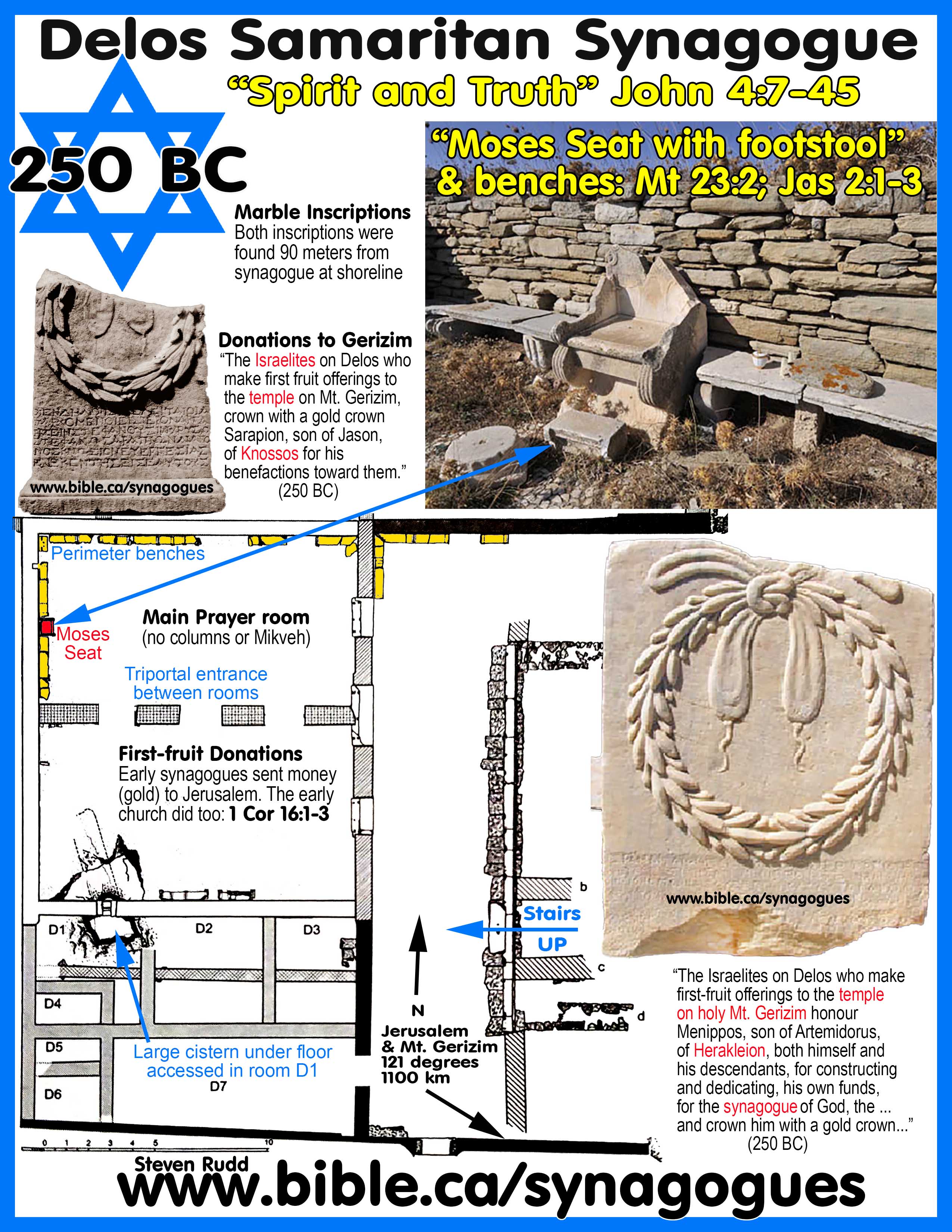
8. The Ephesus synagogue met regularly and made contributions for the Jerusalem Temple:
a. Josephus on the Ephesian synagogue and the imperial decree in 43 BC: “When Artemon was prytanis, on the first day of the month Leneon, Dolabella imperator, to the senate and magistrates, and people of the Ephesians, sendeth greeting. (226) Alexander, the son of Theodorus, the ambassador of Hyrcanus, the son of Alexander the high priest and ethnarch of the Jews, appeared before me, to show that his countrymen could not go into their armies, because they are not allowed to bear arms, or to travel on the Sabbath days, nor there to procure themselves those sorts of food which they have been used to eat from the times of their forefathers,—(227) I do therefore grant them a freedom from going into the army, as the former prefects have done, and permit them to use the customs of their forefathers, in assembling together for sacred and religious purposes, as their law requires, and for collecting oblations necessary for sacrifices; and my will is, that you write this to the several cities under your jurisdiction.” 13. (228) And these were the concessions that Dolabella made to our nation when Hyrcanus sent an embassage to him; but Lucius the consul’s decree ran thus:—“I have at my tribunal set these Jews, who are citizens of Rome, and follow the Jewish religious rites, and yet live at Ephesus, free from going into the army, on account of the superstition they are under.” (Josephus Antiquities 14.225–228, decree: 43 BC)
b. Philo on the Ephesian synagogue: “Caius Norbanus Flaccus, proconsul, to the governors of the Ephesians, greeting. “’Caesar has written word to me, that the Jews, wherever they are, are accustomed to assemble [greek: synago] together, in compliance with a peculiar ancient custom of their nation, to contribute money which they send to Jerusalem; and he does not choose that they should have any hindrance offered to them, to prevent them from doing this; therefore I have written to you, that you may know that I command that they shall be allowed to do these things.’” (Philo, Embassy/Legat. 315)
c. Bible on the Ephesian synagogue:
i. First missionary journey: "They came to Ephesus, and he left them there. Now he himself entered the synagogue and reasoned with the Jews. When they asked him to stay for a longer time, he did not consent, but taking leave of them and saying, “I will return to you again if God wills,” he set sail from Ephesus." (Acts 18:19–21)
ii. Second missionary journey: "Now a Jew named Apollos, an Alexandrian by birth, an eloquent man, came to Ephesus; and he was mighty in the Scriptures. This man had been instructed in the way of the Lord; and being fervent in spirit, he was speaking and teaching accurately the things concerning Jesus, being acquainted only with the baptism of John; and he began to speak out boldly in the synagogue. But when Priscilla and Aquila heard him, they took him aside and explained to him the way of God more accurately. And when he wanted to go across to Achaia, the brethren encouraged him and wrote to the disciples to welcome him; and when he had arrived, he greatly helped those who had believed through grace, for he powerfully refuted the Jews in public, demonstrating by the Scriptures that Jesus was the Christ." (Acts 18:24–28)
iii. Second missionary journey: "And he entered the synagogue and continued speaking out boldly for three months, reasoning and persuading them about the kingdom of God. But when some were becoming hardened and disobedient, speaking evil of the Way before the people, he withdrew from them and took away the disciples, reasoning daily in the school of Tyrannus. This took place for two years, so that all who lived in Asia heard the word of the Lord, both Jews and Greeks." (Acts 19:8–10)
9. Synagogues enjoyed legislative formal protection as refugee/asylum/sanctuary “off limits to non-Jews” status: 300 years old!
a. Since 280 BC when they began in Alexandria, synagogues were considered sanctuary’s that were out of bounds for non-Jews based upon formal proclamations by Ptolemy II, III, IV and Julias Caesar.
b. This three hundred year old sanctuary status that dates back to the genesis of synagogues (280 BC) was violated for the first time around 40 AD when Flaccus encouraged the pagan Egyptians to set up statues of Caligula in the synagogues of Egypt, including an live equestrian display with horse and chariot being set up in the very first and greatest [basilica] synagogue of Alexandra.
c. And one may find undeniable and notorious proofs of this having been the case. For, in the first place, one may derive them from about ten kings or more who reigned in order, one after another, for three hundred years [ie. 262 BC], and who never once had any images or statues of themselves erected in our synagogues, though there were many of their relations and kinsmen whom they considered, and registered as, and spoke of as gods. (139) And what would they not have done in the case of those whom they looked upon as men? a people who look upon dogs, and wolves, and lions, and crocodiles, and numerous other beasts, both terrestrial and aquatic, and numerous birds, as gods, and erect in their honour altars, and temples, and shrines, and consecrated precincts, throughout the whole of Egypt?” (Philo, Embassy/Legat. 138-139, Alexandria, 41-45 AD)
10. The “Therapeutae” were a Jewish monastic order in Egypt of self denial:
a. The “Therapeutae” were a Jewish monastic order in Egypt of self denial and devotion to God that later Christians used as a pattern for Christian monastic orders: Philo describes them:
b. “every house [of one of the Therapeutae] there is a sacred shrine which is called the holy place, and the monastery in which they retire by themselves and perform all the mysteries of a holy life, bringing in nothing, neither meat, nor drink, nor anything else which is indispensable towards supplying the necessities of the body, but studying in that place the laws and the sacred oracles of God enunciated by the holy prophets, and hymns, and psalms, and all kinds of other things by reason of which knowledge and piety are increased and brought to perfection. (26) Therefore they always retain an imperishable recollection of God, so that not even in their dreams is any other object ever presented to their eyes except the beauty of the divine virtues and of the divine powers. Therefore many persons speak in their sleep, divulging and publishing the celebrated doctrines of the sacred philosophy. (27) And they are accustomed to pray twice every day, at morning and at evening; when the sun is rising entreating God that the happiness of the coming day may be real happiness, so that their minds may be filled with heavenly light, and when the sun is setting they pray that their soul, being entirely lightened and relieved of the burden of the outward senses, and of the appropriate object of these outward senses, may be able to trace out truth existing in its own consistory and council chamber. (28) And the interval between morning and evening is by them devoted wholly to meditation on and to practice of virtue, for they take up the sacred scriptures and philosophise concerning them, investigating the allegories of their national philosophy, since they look upon their literal expressions as symbols of some secret meaning of nature, intended to be conveyed in those figurative expressions” (Philo, Contemplation of Life 25-28, 15 AD)
IV. Philo of Alexandria followed the Genesis chronology of the Septuagint
1. In Philo QG I 82-84 (30 AD) Philo’s chronological numbers for Enoch are the identical to the Septuagint (LXX) at 165 [age at birth of son], 200 [years lived after son], 365 [age at death] and variant to the Masoretic Text (MT) with read 65 [age at birth of son], 300 [years lived after son], 365 [age at death].
a. What is immediately noticeable in the MT is that this is a systematic change of two numbers so that their sum before and after the change add up the same total of 365 years lived.
b. He also mentions Enoch’s numbers 165, 200, 365 in QG I 82-83 and Noah’s age of 600 at the Flood in QG II 17.
2. Text of Philo:
a. “What is the meaning of the verse, Enoch pleased God after he begat Methuselah, two hundred years? (Genesis 5:22). [This is at variance with the statement in the Bible, which says he lived sixty-five years before the birth of Methuselah, and walked with God three hundred years.] God appointed by the law the fountains of all good things to be under the principles of generation itself. And what I mean is something of this sort. A little while before he appointed mercy and pardon to exist, now again he decrees that penitence shall exist, not in any degree mocking or reproaching these men, who are believed to have offended, and at the same time giving the soul an opportunity to mount up from wickedness to virtue, like the conversion of those who are proceeding towards a snare. For behold, the man being made a husband and a father together with his birth, makes a beginning of honesty. And he is said to please God, for although he does not persevere in piety from the moment that he is born, nevertheless, all that remaining period is counted to him as having been spent in a praiseworthy mode of life, because he pleased God for so many years. And these things are said, not because it perhaps was, but it might perhaps have seemed different; but he approves of the order of things, for indulgence having been exemplified, in this case of Cain, after no long interval of time, he introduces this statement, that Enoch practised repentance, warning us by it that repentance alone can procure indulgence. (83) Why Enoch, who cultivated repentance, is said to have lived before his repentance a hundred and sixty-five years, but two hundred after his repentance? (Genesis 5:22). This number of a hundred and sixty-five is combined of the singular addition of ten numbers from the unit to ten; as one, two, three, four, five, six, seven, eight, nine, ten, the total of which is fifty-five. And again, from that by the addition of ten numbers, which, removing the unit proceed upwards by twos, and two, four, six, eight, ten, twelve, fourteen, sixteen, eighteen, twenty, which make a hundred and ten; the combination of which, with the numbers first mentioned, produces a hundred and sixty-five; and in this addition the even numbers amount to twice as much as the odd numbers; for the woman is more violent than the man, in the preposterous manner in which the wicked man rules over the virtuous man, the outward sense over the mind, the body over the outward sense, and matter over its cause. But the number two hundred, in which repentance was practised, is combined of two numbers of one hundred, the first hundred of which intimates a purification from injustice, but the other indicates the plenitude of perfect virtue. In truth, before anything else is done, the first thing is to cut off from a sick body every diseased part, and after that means of cure are to be applied to it, for this is the first step, and the other the second. Moreover, the number two hundred consists of fours, for it is produced as from seed, from four triangular numbers, and from four tetragons, and from four pentagons, and from four hexagons, and from four heptagons; and, as one may say, it fixes its step on the number seven. Now the four triangles are these, one, three, six, ten, which make twenty; the four tetragons are one, four, nine, sixteen, which make thirty; from the four pentagons, one, five, twelve, twenty-two, is made the number forty. Moreover, the four hexagons, one, six, fifteen, twenty-eight, make fifty; and the four heptagons, one, seven, eighteen, thirty-four, make sixty; and all these numbers put together make two hundred. (84) Why the man who lives a life of repentance is said to have lived three hundred and sixtyfive years? (Genesis 5:23). In the first place, the year contains three hundred and sixty-five days; therefore, by the symbol of the solar orbit, the sacred historian here indicates the life of the repentant man. In the second place, as the sun is the cause of day and night, performing his revolutions by day above the hemisphere of the earth, and his course by night under the earth, so also the life of the man of repentance consists of alternations of light and darkness; of darkness, that is, of times of agitation and circumstances of injury; and of light, when the light of virtue and its radiant brilliancy arises. In the third place, he has assigned to him a complete number, as the sun is ordained to be the chief of the stars of heaven, under an appointed number, in the time which came before the period of his repentance, to lead to the oblivion of the sins previously committed; since, as God is good, he bestows the greatest favours most abundantly, and, at the same time, he effaces the former offences of those who devote themselves to him, and which might deserve chastisement, by a recollection of their virtues. (Philo QG I 82–84, 30 AD).
By Steve Rudd 2017: Contact the author for comments, input or corrections
|
Jesus your messiah is waiting for you to come home! |
|
|
Why not worship with a first century New Testament church near you, that has the same look and feel as the Jewish Synagogue in your own home town. As a Jew, you will find the transition as easy today as it was for the tens of thousands of your forefathers living in Jerusalem 2000 years ago when they believed in Jesus the Nazarene (the branch) as their messiah. It’s time to come home! |
|
By Steve Rudd: Contact the author for comments, input or corrections.
Go to: Main Ancient Synagogue Start Page
